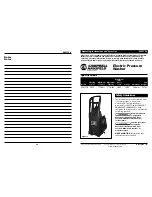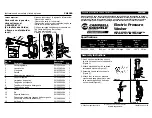
33
In Canada
4.
Plug into a grounded 4-prong outlet
Complete Installation Checklist
T
Check that all parts are now installed. If there is an extra
part, go back through the steps to see which step was
skipped.
T
Check that you have all of your tools.
T
Dispose of/recycle all packaging materials. Keep the plastic
foam for use if the washer/dryer should be transported.
T
Check the washer/dryer’s final location. Be sure the vent is
not crushed or kinked.
T
Check that the washer/dryer is level and front leveling feet
are tight. See “Level Washer/Dryer.”
In the U.S.A.:
T
For power supply cord installation, plug into a grounded
outlet. For direct wire installation, turn on power.
In Canada:
T
Plug into a grounded 4-prong outlet. Turn on power.
T
Check that the water faucets are on.
T
Check for leaks around faucets and inlet hoses.
T
Remove the protective film on the console and any tape
remaining on the washer/dryer.
T
Read the Washer/Dryer Use and Care Guide.
T
Wipe the dryer drum interior thoroughly with a damp cloth
to remove any dust.
T
To test the washer, measure 1/2 the normal recommended
amount of detergent and pour it into the washer. Close the
lid. Select HEAVY and pull out the Cycle Control knob. Allow
the washer to complete one whole cycle.
T
To test the dryer, set the dryer on a full heat cycle (not an air
cycle) for 20 minutes and start the dryer.
If the dryer will not start, check the following:
• Controls are set in a running or “On” position.
• PUSH TO START button has been firmly pushed.
• Washer/dryer is plugged into a grounded outlet.
• Electrical supply is connected.
• Household fuses are intact and tight, or circuit breakers
have not tripped.
• Dryer door is closed.
T
When the dryer has been running for 5 minutes, open the
dryer door and feel for heat.
If you do not feel heat, turn off the dryer and check the
following:
• There may be 2 household fuses or circuit breakers for the
dryer. Check that both fuses are intact and tight, or that
both circuit breakers have not tripped. If there is still no
heat, contact a qualified technician.
NOTE:
You may notice an odor when dryer is first heated. This
odor is common when the heating element is first used. The odor
will go away.

































